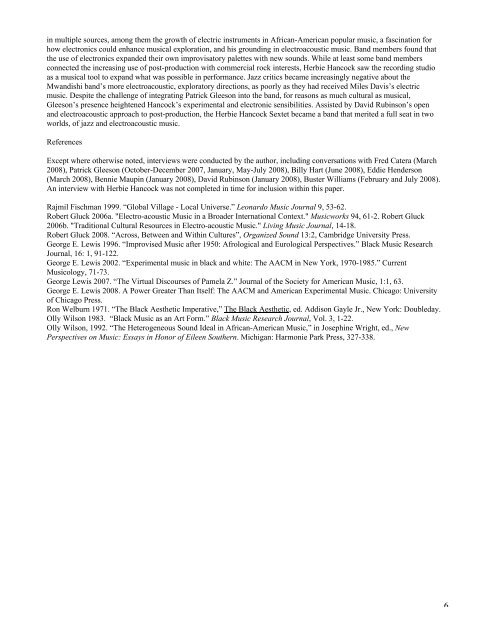the Mwandishi band - Bob Gluck
the Mwandishi band - Bob Gluck
the Mwandishi band - Bob Gluck
You also want an ePaper? Increase the reach of your titles
YUMPU automatically turns print PDFs into web optimized ePapers that Google loves.
in multiple sources, among <strong>the</strong>m <strong>the</strong> growth of electric instruments in African-American popular music, a fascination for<br />
how electronics could enhance musical exploration, and his grounding in electroacoustic music. Band members found that<br />
<strong>the</strong> use of electronics expanded <strong>the</strong>ir own improvisatory palettes with new sounds. While at least some <strong>band</strong> members<br />
connected <strong>the</strong> increasing use of post-production with commercial rock interests, Herbie Hancock saw <strong>the</strong> recording studio<br />
as a musical tool to expand what was possible in performance. Jazz critics became increasingly negative about <strong>the</strong><br />
<strong>Mwandishi</strong> <strong>band</strong>’s more electroacoustic, exploratory directions, as poorly as <strong>the</strong>y had received Miles Davis’s electric<br />
music. Despite <strong>the</strong> challenge of integrating Patrick Gleeson into <strong>the</strong> <strong>band</strong>, for reasons as much cultural as musical,<br />
Gleeson’s presence heightened Hancock’s experimental and electronic sensibilities. Assisted by David Rubinson’s open<br />
and electroacoustic approach to post-production, <strong>the</strong> Herbie Hancock Sextet became a <strong>band</strong> that merited a full seat in two<br />
worlds, of jazz and electroacoustic music.<br />
References<br />
Except where o<strong>the</strong>rwise noted, interviews were conducted by <strong>the</strong> author, including conversations with Fred Catera (March<br />
2008), Patrick Gleeson (October-December 2007, January, May-July 2008), Billy Hart (June 2008), Eddie Henderson<br />
(March 2008), Bennie Maupin (January 2008), David Rubinson (January 2008), Buster Williams (February and July 2008).<br />
An interview with Herbie Hancock was not completed in time for inclusion within this paper.<br />
Rajmil Fischman 1999. “Global Village - Local Universe.” Leonardo Music Journal 9, 53-62.<br />
Robert <strong>Gluck</strong> 2006a. "Electro-acoustic Music in a Broader International Context." Musicworks 94, 61-2. Robert <strong>Gluck</strong><br />
2006b. "Traditional Cultural Resources in Electro-acoustic Music." Living Music Journal, 14-18.<br />
Robert <strong>Gluck</strong> 2008. “Across, Between and Within Cultures”, Organized Sound 13:2, Cambridge University Press.<br />
George E. Lewis 1996. “Improvised Music after 1950: Afrological and Eurological Perspectives.” Black Music Research<br />
Journal, 16: 1, 91-122.<br />
George E. Lewis 2002. “Experimental music in black and white: The AACM in New York, 1970-1985.” Current<br />
Musicology, 71-73.<br />
George Lewis 2007. “The Virtual Discourses of Pamela Z.” Journal of <strong>the</strong> Society for American Music, 1:1, 63.<br />
George E. Lewis 2008. A Power Greater Than Itself: The AACM and American Experimental Music. Chicago: University<br />
of Chicago Press.<br />
Ron Welburn 1971. “The Black Aes<strong>the</strong>tic Imperative,” The Black Aes<strong>the</strong>tic, ed. Addison Gayle Jr., New York: Doubleday.<br />
Olly Wilson 1983. “Black Music as an Art Form.” Black Music Research Journal, Vol. 3, 1-22.<br />
Olly Wilson, 1992. “The Heterogeneous Sound Ideal in African-American Music,” in Josephine Wright, ed., New<br />
Perspectives on Music: Essays in Honor of Eileen Sou<strong>the</strong>rn. Michigan: Harmonie Park Press, 327-338.<br />
6



